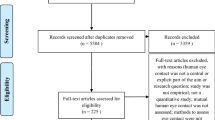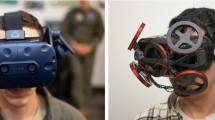Abstract
Digital eye strain (DES) is a growing occupational and public health problem and one of the most frequent reasons for seeking medical care. The objectives of this study are to identify the prevalence and to study some associated personal, ergonomic, and environmental factors of DES among information technology (IT) professionals at Tanta University, Egypt. An interview questionnaire was used to collect data related to socio-demographic, job, ergonomic and environmental characteristics. Computer vision syndrome questionnaire (CVS-Q) was used for the assessment of DES. It was used to measure ocular and visual symptoms related to computer use. CVS-Q includes 16 symptoms that are scored using two rating scales, one for frequency and the other for intensity. A total of 108 IT professionals were included. Prevalence of DES was 82.41%. The most common symptoms were headache (81.5%), burning of the eye (75.9%), and blurred vision (70.4%). Significant predictors of DES were female gender (OR = 2.845), age ≥ 35 years (OR = 1.112), daily computer use more than 6 h (OR = 1.351), duration of work more than 10 years (OR = 1.793), wearing corrective glasses (OR = 5.009), distance from the monitor less than 20 in. (OR = 4.389), not using antiglare screen (OR = 0.214), no brightness adjustment of screen (OR = 0.015), not taking break time during computer work (OR = 0.007), exposure to air pollution (OR = 5.667), use of the air conditioner (OR = 23.021), and exposure to windy environments (OR = 3.588). Prevalence of DES was found to be high among IT professionals. Significant predictors of DES were female gender, older age, wearing eyeglasses, long duration of computer use, unadjusted ergonomic workstation, and dry environment. DES is a problem that can be prevented by increasing knowledge and awareness about DES by providing computer users with eye health education, periodic training on a proper ergonomic computer workstation, and adjustment of the suitable comfortable workplace environment.

Similar content being viewed by others
Data availability
Not available.
References
Agarwal SD, Sharma AG (2013) Evaluation of the factors which contribute to the ocular complaints in computer users. J Clin Diagn Res 7(2):331–335
Alemayehu MA, Nega ET, Mule Y (2014) Prevalence of self-reported computer vision syndrome and associated factors among secretaries and data processors who are working in University of Gondar, Ethiopia. Prevalence 4(15)
Amick BC, Menéndez CC, Bazzani L, Robertson M, Derango K, Rooney T, Moore A (2012) A field intervention examining the impact of an office ergonomics training and a highly adjustable chair on visual symptoms in a public sector organization. Appl Ergon 43(3):625–631
Artime Ríos EM, Sánchez Lasheras F, Suárez Sánchez A, Iglesias-Rodríguez FJ, Seguí Crespo MM (2019) Prediction of computer vision syndrome in health personnel by means of genetic algorithms and binary regression trees. Sensors 2800(19). https://doi.org/10.3390/s19122800
Arumugam S, Kumar K, Subramani R, Kumar S (2014) Prevalence of computer vision syndrome among information technology professionals working in Chennai. World Journal of Medical Sciences 11(3):312–314
Assefa NL, Weldemichael DZ, Alemu HW, Anbesse DH (2017) Prevalence and associated factors of computer vision syndrome among bank workers in Gondar City, Northwest Ethiopia, 2015. Clin Optom 9:67–76
Bali J, Navin N, Thakur BR (2007) Computer vision syndrome: a study of the knowledge, attitudes and practices in Indian ophthalmologists. Indian J Ophthalmol 55(4):289–294
Bansal A, Bansal R, Prajapati S, Prajapati P (2013) A cross sectional study to determine the prevalence of computer related health problems among students of information technology in various college of Surat City. Int J Res Med 2(2):48–51
Bhanderi DJ, Choudhary S, Doshi VG (2008) A community-based study of asthenopia in computer operators. Indian J Ophthalmol 56(1):51–55
Blehm C, Vishnu S, Khattak A, Mitra S, Yee RW (2005) Computer vision syndrome: a review. Surv Ophthalmol 50(3):253–262
Brindha AK, Murthy S, Trout K, Singh AK, Surapaneni KM, Joshi A (2015) Dry eyes among information technology professionals in India. Guoji Yanke Zazhi. Int Eye Sci 15(8):1303–1308
Charpe NA, Kaushik V (2009) Computer vision syndrome (CVS): recognition and control in software professionals. J Hum Ecol 28(1):67–69
Davari MH, Karimi GH, Sajjadi SH (2017) Determining the frequency of dry eye in computer users and comparing with control group. Guoji Yanke Zazhi( Int Eye Sci) 17(8):1410–1414
Fenety A, Walker JM (2002) Short-term effects of workstation exercises on musculoskeletal discomfort and postural changes in seated video display unit workers. Phys Ther 82(6):578–589
Hayes JR, Sheedy JE, Stelmack JA, Heaney CA (2007) Computer use, symptoms, and quality of life. Optom Vis Sci 84(8):E738–E755
Izquierdo J, Garcia M, Buxo C, Izquierdo N (2007) Factors leading to the computer vision syndrome: an issue at the contemporary workplace. Bol Asoc Med P R 99(1):21–28
Kamal NN, El-Mageed ASA (2018) Determinants of computer vision syndrome among bank employees in Minia City, Egypt. Egyptian Journal of Community Medicine 36(4)
Le Q, Ge L, Li M, Wu L, Xu J, Hong J, Gong L (2014) Comparison on the vision-related quality of life between outpatients and general population with dry eye syndrome. Acta Ophthalmol 92(2):e124–e132
Lee BS, Kabat AG, Bacharach J, Karpecki P Luchs J (2020) Managing dry eye disease and facilitating realistic patient expectations: a review and appraisal of current therapies. Clinical Ophthalmology (Auckland, NZ) 14: 119
Logaraj M, Madhupriya V (2014) Computer vision syndrome and associated factors among medical and engineering students in Chennai. Annals of medical and health sciences research 4(2):179–185
Mocci F, Serra A, Corrias G (2001) Psychological factors and visual fatigue in working with video display terminals. Occup Environ Med 58(4):267–271
Reddy SC, Low C, Lim Y, Low L, Mardina F and Nursaleha M (2013) Computer vision syndrome: a study of knowledge and practices in university students. Nepal J Ophthalmol 5(2):161–168
Parihar J, Jain VK, Chaturvedi P, Kaushik J, Jain G, Parihar AK (2016) Computer and visual display terminals (VDT) vision syndrome (CVDTS). Med J Armed Forces India 72(3):270–276
Rafeeq U, Omear M, Chauhan L, Maan V, Agarwal P (2020) Computer vision syndrome among individuals using visual display terminals for more than two hours. Delta Journal of Ophthalmology 21(3):139–145. https://doi.org/10.4103/DJO.DJO_65_19
Rahman ZA, Sanip S (2011) Computer user: demographic and computer related factors that predispose user to get computer vision syndrome. Int J Bus, Humanit Technol 1(2):84–91
Raja AM, Janti S, Matheen A, Chendilnathan C, Ramalingam P (2015) Cross-sectional questionnaire study of ocular effects among IT professionals who use computers. International Journal of Medicine and Public Health 5(1)
Ranasinghe PW, Wathurapatha Y, Perera D, Lamabadusuriya S, Kulatunga NJ, Katulanda P (2016) Computer vision syndrome among computer office workers in a developing country: an evaluation of prevalence and risk factors. BMC research notes 9(1):150
Rosenfield M (2011) Computer vision syndrome: a review of ocular causes and potential treatments. Ophthalmic Physiol Opt 31(5):502–515
Seguí MM, Cabrero-García J, Crespo A, Verdú J, Ronda E (2015) A reliable and valid questionnaire was developed to measure computer vision syndrome at the workplace. J Clin Epidemiol 68(6):662–673. https://doi.org/10.1016/j.jclinepi.2015.01.015
Sen A, Richardson S (2007) A study of computer-related upper limb discomfort and computer vision syndrome. J Hum Ergol 36(2):45–50
Shalaby OE, Awara AM, Shafik HM, DA EL-S (2018) Ocular surface alterations in visual display terminal users. Med J Cairo Univ 86(5):2579–2584
Sharma B (2011) Dry eye: demography and attributable risk factors. Post-Graduate Medical Journal of NAMS 11(01)
Sheedy JE, Hayes J, Jon E (2003) Is all asthenopia the same? Optom Vis Sci 80(11):732–739
Taptagaporn SM, Sotoyama SS, Suzuki T (1995) Visual comfort in VDT workstation design. J Hum Ergol 24(1):84–88
Tesfa M, Sadik MI, Markos Y & Aleye LT. (2019). Prevalence and predictors of computer vision syndrome among secretary employees working in Jimma University, Southwest Ethiopia: a cross sectional study at Jimma University. https://doi.org/10.21203/rs.2.10957/v1
Toomingas A, Hagberg M, Heiden MH, Richter KE, Tornqvist EW (2014) Risk factors, incidence and persistence of symptoms from the eyes among professional computer users. Work 47(3):291–301
Uchino M, Yokoi N, Uchino Y, Dogru M, Kawashima M, Komuro A, Sonomura Y, Kato H, Kinoshita S, Schaumberg DA (2013) Prevalence of dry eye disease and its risk factors in visual display terminal users: the Osaka study. Am J Ophthalmol 156(4):759–766. e751
Zakai MU, Mehrotra N, Agarwal A, Verma JS, Bajpai A (2017) Cross-sectional study of computer vision syndrome among human resource professionals in tertiary care hospital. Invertis Journal of Science and Technology 10(1):27–30
Author information
Authors and Affiliations
Contributions
Hanaa Abdelaziz Zayed: selection of the idea of the research paper, participated in data collection and statistical analysis of data, and she was a major contributor in writing and revision of the manuscript; Shimaa Mohammad Saied: conceptualization of the study, shared in writing, statistical analysis of data, and editing and revision of the manuscript. Eman Ali Younis: participated in data collection and writing of the paper. Salwa Abd Elmagid Atlam: shared in writing and revision of the manuscript.
Corresponding author
Ethics declarations
Conflict of interest
The authors declare that they have no conflicts of interest.
Ethical approval
This study was approved by Tanta Faculty of Medicine Research Ethics Committee (REC).
Informed consent
Informed written consent was taken from all study participants.
Consent to publish
Not applicable.
Additional information
Responsible Editor: Lotfi Aleya
Publisher’s note
Springer Nature remains neutral with regard to jurisdictional claims in published maps and institutional affiliations.
Rights and permissions
About this article
Cite this article
Zayed, H.A.M., Saied, S.M., Younis, E.A. et al. Digital eye strain: prevalence and associated factors among information technology professionals, Egypt. Environ Sci Pollut Res 28, 25187–25195 (2021). https://doi.org/10.1007/s11356-021-12454-3
Received:
Accepted:
Published:
Issue Date:
DOI: https://doi.org/10.1007/s11356-021-12454-3




